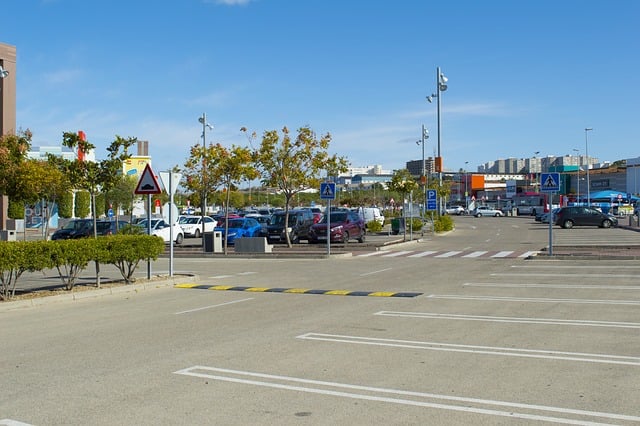EXPLAINED: What are the rules for parking in Spain?

If you plan on buying or renting a car, haven’t managed to switch over your UK licence yet or you’ve just moved here and are unfamiliar with the rules, here’s everything you need to know about parking in Spain.
If you're planning on driving in Spain, it's important you familiarise yourself with all the rules here, not only when moving, but while parked too. Here's what all the different coloured lines mean for parking on the street.
White lines
These are the easiest and simple to understand in Spain and mean that you can park anywhere within the lines, at any time for free.
READ ALSO - Driving in Spain: What changes in 2023?
Blue lines
Parking within blue lines means they are designed for visitors and you must pay to leave your vehicle there. You can make your payment at the nearest parking meter.
Be aware that each region in Spain has different rules on how long you can park your car somewhere without incurring a fine, find out what they are here.
In general, the rules apply Monday to Friday from 9am to 9pm, and on Saturdays from 9am to 3pm. Sundays and holidays, there are no restrictions. The schedule can vary in summer though in popular destinations, so always look on the signs and the parking meter to find out.
Green and orange lines
Parking within green and orange lines is reserved for residents of the area who are registered to park in those particular zones.
To obtain a permit to park within the orange and green lines, you must contact your local ayuntamiento or town hall and present the necessary documents such as your padrón certificate, driving licence and evidence you own a vehicle.
It will also be necessary to make a payment to use this service. Once you’re registered you can use both the orange and green zones without any restrictions.
Visitors can also use green and orange parking zones, but there are restrictions in place and they must pay. The price of parking within green or orange lines is always higher than the price of parking within the blue lines and you are only allowed to park for a limited time.
The duration can vary from region to region, but it’s typically only 2 hours before you’ll have to move your car. You must remember to pay straight away and leave a ticket in your window to prove you’ve done so.

You can park freely within white lines in Spain. Photo: Anatolii Maks / Pixabay
Is there a difference between the green lines and the orange ones?
No, there is no difference whatsoever, you can treat them exactly the same. It may depend on the city you’re in. For example, in Madrid, Barcelona and Seville you’ll find more green lines and in Valencia and Alicante you’ll find more orange ones.
Area exclusively for residents
Some cities also have special exclusive resident zones, these areas are depicted by showing a red circle with an X through it and a light blue background. It will also have either orange or green lines on the street, as well as this sign saying 'Zona exclusiva de residentes' (Area exclusively for residents) or 'área residents' (residents’ area).
READ ALSO: How Spain’s new low-emission zones will affect drivers
Loading and unloading zone
These zones are marked with yellow zigzag lines, as well as a dark blue circle outlined in red and with a diagonal red slash through the middle. It is forbidden to park at any time in these areas and they’re only for loading and unloading. The maximum time for this is around 30 minutes. The sign will also indicate any additional rules, but they typically apply from Monday to Friday 8am to 8pm.
Blue-Orange lines
A dotted blue and orange line indicates one of two situations. It’s either for those visiting a health centre or hospital, where you can park for a maximum of 4 hours or it’s a long-stay area near to a train station for example. You must pay for long-stay parking spots, but they will be at a reduced rate and you can leave your car for up to 12 hours.
Yellow line
A yellow line means that parking is prohibited at all times. They are usually placed in front of garages, the entrance to car parks and areas reserved for service vehicles such as police cars or ambulances.

No parking, except for the library bus. Photo: Daniel Capilla / WikiCommons
A red circle with a blue background and an X through the middle
This sign indicates that stopping and parking are prohibited in this area.
A red circle with a blue background and one diagonal line through the middle
This means that parking is prohibited but you can stop if absolutely necessary for less than 2 minutes when the driver is in the car.
VADO
If you leave the vehicle in the regulated parking area, but do not pay for parking, you will be fined, but if you park in an area labelled VADO, your car will be towed away, as well as having to pay.
Comments
See Also
If you're planning on driving in Spain, it's important you familiarise yourself with all the rules here, not only when moving, but while parked too. Here's what all the different coloured lines mean for parking on the street.
White lines
These are the easiest and simple to understand in Spain and mean that you can park anywhere within the lines, at any time for free.
READ ALSO - Driving in Spain: What changes in 2023?
Blue lines
Parking within blue lines means they are designed for visitors and you must pay to leave your vehicle there. You can make your payment at the nearest parking meter.
Be aware that each region in Spain has different rules on how long you can park your car somewhere without incurring a fine, find out what they are here.
In general, the rules apply Monday to Friday from 9am to 9pm, and on Saturdays from 9am to 3pm. Sundays and holidays, there are no restrictions. The schedule can vary in summer though in popular destinations, so always look on the signs and the parking meter to find out.
Green and orange lines
Parking within green and orange lines is reserved for residents of the area who are registered to park in those particular zones.
To obtain a permit to park within the orange and green lines, you must contact your local ayuntamiento or town hall and present the necessary documents such as your padrón certificate, driving licence and evidence you own a vehicle.
It will also be necessary to make a payment to use this service. Once you’re registered you can use both the orange and green zones without any restrictions.
Visitors can also use green and orange parking zones, but there are restrictions in place and they must pay. The price of parking within green or orange lines is always higher than the price of parking within the blue lines and you are only allowed to park for a limited time.
The duration can vary from region to region, but it’s typically only 2 hours before you’ll have to move your car. You must remember to pay straight away and leave a ticket in your window to prove you’ve done so.

Is there a difference between the green lines and the orange ones?
No, there is no difference whatsoever, you can treat them exactly the same. It may depend on the city you’re in. For example, in Madrid, Barcelona and Seville you’ll find more green lines and in Valencia and Alicante you’ll find more orange ones.
Area exclusively for residents
Some cities also have special exclusive resident zones, these areas are depicted by showing a red circle with an X through it and a light blue background. It will also have either orange or green lines on the street, as well as this sign saying 'Zona exclusiva de residentes' (Area exclusively for residents) or 'área residents' (residents’ area).
READ ALSO: How Spain’s new low-emission zones will affect drivers
Loading and unloading zone
These zones are marked with yellow zigzag lines, as well as a dark blue circle outlined in red and with a diagonal red slash through the middle. It is forbidden to park at any time in these areas and they’re only for loading and unloading. The maximum time for this is around 30 minutes. The sign will also indicate any additional rules, but they typically apply from Monday to Friday 8am to 8pm.
Blue-Orange lines
A dotted blue and orange line indicates one of two situations. It’s either for those visiting a health centre or hospital, where you can park for a maximum of 4 hours or it’s a long-stay area near to a train station for example. You must pay for long-stay parking spots, but they will be at a reduced rate and you can leave your car for up to 12 hours.
Yellow line
A yellow line means that parking is prohibited at all times. They are usually placed in front of garages, the entrance to car parks and areas reserved for service vehicles such as police cars or ambulances.

A red circle with a blue background and an X through the middle
This sign indicates that stopping and parking are prohibited in this area.
A red circle with a blue background and one diagonal line through the middle
This means that parking is prohibited but you can stop if absolutely necessary for less than 2 minutes when the driver is in the car.
VADO
If you leave the vehicle in the regulated parking area, but do not pay for parking, you will be fined, but if you park in an area labelled VADO, your car will be towed away, as well as having to pay.
Join the conversation in our comments section below. Share your own views and experience and if you have a question or suggestion for our journalists then email us at [email protected].
Please keep comments civil, constructive and on topic – and make sure to read our terms of use before getting involved.
Please log in here to leave a comment.